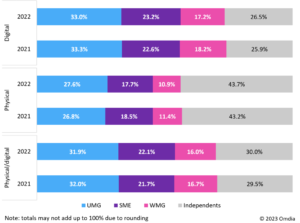 The latest issue of Music & Copyright is now available for subscribers to download. Here are some of the highlights.
The latest issue of Music & Copyright is now available for subscribers to download. Here are some of the highlights.
SPECIAL FOCUS: The jury’s still out on OTT video and the cannibalization of broadcast TV rights collections
Over-the-top (OTT) streaming of audio and video is a distribution means that has quickly become the leading method of consumption for both media content industries. In contrast to traditional broadcast, OTT is a process that uses the open internet rather than a service provider’s own infrastructure. Multiple services, including those from pure-play providers, such as Netflix, Disney, and Amazon, are now available worldwide. Moreover, revenue from OTT services now exceeds pay TV, and growing numbers of consumers are continuing to find the flexibility and convenience of OTT offerings preferable to traditional broadcast services. However, with the competition for viewing intensifying, TV collections are coming under pressure. Although most collective management organizations (CMOs) have seen OTT video income rise at a faster rate than TV collections have fallen, there are no guarantees that this status quo will continue indefinitely.
NEWS FEATURE: Digital and public performance gains boost APRA AMCOS receipts to new heights
Australian authors’ society APRA AMCOS has reported another big rise in rights collections. The new record-high figure is for the financial year ending June, with the total boosted by a positive 12 months for digital and a big jump in public performance receipts. The year in review marked the first not to be affected by the COVID-19 pandemic since the 2018/19 financial year. Public performance was the sector hardest hit by the virus, and last year saw the revenue source register the highest gains of all the main income sectors. TV and radio receipts were down year-on-year, while mechanical collections benefited from the resurgence in vinyl sales. Revenue from overseas returned to growth after a fall in the prior year.
SECTOR ANALYSIS: NFTs evolve beyond financial speculation to music-oriented utility
The non-fungible token (NFT), which was once the brief showpiece of the music-technology integration trend, has fallen from grace, and the Bored Apes have lost their allure. Music NFTs got caught up in and took advantage of a speculative bubble that saw a huge majority of investors get their fingers burned. However, tokenization has now shifted into the next stage of development that will see new use cases emerge. While these may seem less thrilling than the one-time sky-high prices achieved at NFT auctions, they will likely offer solutions to tackle music business counterfeiting and provide new revenue streams across both the live and recorded-music sectors.
COUNTRY REPORT: Italy
In addition to the usual set of music industry statistics and news briefs, the latest issue of Music & Copyright includes a detailed Italy music industry report. Before the COVID-19 pandemic, Italy’s recorded-music sector had experienced several erratic years, largely due to the lingering dominance of physical formats. However, digital trade sales overtook physical formats in 2018, with a sharp rise in subscription sales more than offsetting falls in CD album sales and vinyl. The pattern of sales continued into 2019, but the toll from pandemic-related government restrictions on physical formats and performance rights in 2020 resulted in a flat year overall. Sales bounced back strongly in 2021, and last year saw more of the same. Midyear sales details published by the local trade association FIMI suggest Italy is heading for another year of double-digit percentage point growth. UMG remains the clear leader in market share terms despite a fall in share and a rise for second-placed SME. After suffering a sharp fall in collections in 2020, revenue for the local authors’ society SIAE returned to growth in 2021. Last year saw a sharp rise in revenue and receipts from rights collections, with the totals benefiting from the full return of live performance. Ticket sales to live music events continued to recover in 2022 but are not forecast to top prepandemic levels until next year.
If you would like more information about the newsletter or to set up a subscription, then send us an email Alternatively, if you would like to download a sample copy, just go here.
- SEO Powered Content & PR Distribution. Get Amplified Today.
- PlatoData.Network Vertical Generative Ai. Empower Yourself. Access Here.
- PlatoAiStream. Web3 Intelligence. Knowledge Amplified. Access Here.
- PlatoESG. Carbon, CleanTech, Energy, Environment, Solar, Waste Management. Access Here.
- PlatoHealth. Biotech and Clinical Trials Intelligence. Access Here.
- Source: https://musicandcopyright.wordpress.com/2023/10/24/new-issue-of-music-copyright-with-italy-country-report-7/
- :has
- :is
- :not
- $UP
- 12
- 12 months
- 2018
- 2019
- 2020
- 2021
- 2022
- a
- About
- achieved
- across
- addition
- ADvantage
- affected
- After
- Album
- All
- allure
- Although
- Amazon
- an
- analysis
- and
- Another
- Apes
- ARE
- AS
- Association
- At
- Auctions
- audio
- Australian
- available
- back
- BE
- become
- before
- benefiting
- Beyond
- Big
- boost
- Boosted
- Bored
- Bored Apes
- both
- broadcast
- bubble
- burned
- business
- but
- by
- cases
- caught
- CD
- clear
- collections
- Collective
- COM
- coming
- competition
- Consumers
- consumption
- content
- continue
- continued
- continuing
- contrast
- convenience
- copyright
- counterfeiting
- country
- COVID-19
- COVID-19 pandemic
- Despite
- detailed
- details
- Development
- digital
- Disney
- Display
- distribution
- Dominance
- down
- download
- due
- emerge
- ending
- entertain
- Ether (ETH)
- events
- evolve
- exceeds
- experienced
- Fall
- Fallen
- Falls
- faster
- Feature
- Figure
- Files
- financial
- Find
- First
- flat
- Flexibility
- Focus
- For
- Forecast
- from
- full
- Gains
- get
- Go
- got
- Government
- grace
- Growing
- Growth
- guarantees
- had
- Have
- Heading
- here
- highest
- highlights
- Hit
- However
- HTTPS
- huge
- if
- in
- includes
- Including
- Income
- industries
- industry
- information
- Infrastructure
- integration
- intensifying
- Internet
- into
- Investors
- issue
- Italy
- jump
- june
- just
- largely
- Last
- Last Year
- latest
- leader
- leading
- less
- levels
- like
- likely
- live
- local
- lost
- Main
- Majority
- management
- marked
- Market
- market share
- max-width
- May..
- means
- mechanical
- Media
- method
- MidYear
- months
- more
- Moreover
- most
- multiple
- Music
- music business
- music events
- music industry
- Netflix
- New
- news
- Newsletter
- next
- NFT
- NFTs
- no
- non-fungible
- non-fungible token
- Non-Fungible Token (NFT)
- None
- now
- numbers
- of
- offer
- Offerings
- offsetting
- on
- once
- open
- or
- organizations
- out
- overall
- overseas
- own
- pandemic
- Pattern
- Pay
- percentage
- performance
- physical
- plato
- Plato Data Intelligence
- PlatoData
- Point
- positive
- preferable
- pressure
- Prices
- Prior
- process
- provide
- providers
- public
- published
- quickly
- Radio
- Rate
- rather
- receipts
- Recover
- register
- remains
- report
- Reported
- restrictions
- resulted
- return
- revenue
- review
- rights
- Rise
- sales
- same
- saw
- sector
- Sectors
- see
- seem
- seen
- send
- service
- Services
- set
- several
- Share
- sharp
- shifted
- Simon
- since
- SME
- Society
- Solutions
- some
- Source
- speculation
- speculative
- Stage
- statistics
- Status
- Still
- streaming
- streams
- strongly
- subscribers
- subscription
- such
- suffering
- suggest
- tackle
- terms
- than
- that
- The
- their
- then
- There.
- These
- they
- this
- those
- thrilling
- ticket
- ticket sales
- to
- token
- Tokenization
- took
- top
- Total
- trade
- traditional
- Trend
- tv
- under
- until
- us
- use
- uses
- usual
- Video
- viewing
- vinyl
- virus
- was
- were
- which
- while
- will
- with
- WordPress
- worldwide
- would
- year
- years
- you
- zephyrnet












